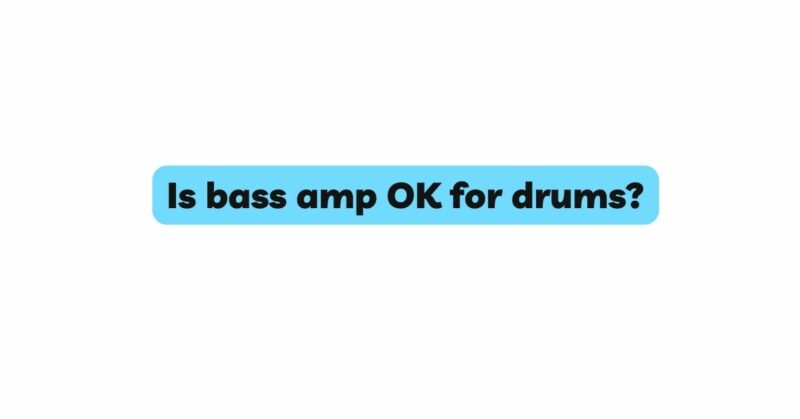In the world of music, where rhythms converge and melodies intertwine, the compatibility between instruments is essential for creating a cohesive and captivating sonic experience. When it comes to the dynamic duo of bass amps and drums, questions arise about whether a bass amp is suitable for handling the powerful percussive force of drum kits. This article delves into the intricacies of using a bass amp for drums, exploring the compatibility, considerations, and collaborative potential that lie within this harmonious partnership.
Understanding Bass Amps and Drums Compatibility: At the core of the compatibility question is the concept of sonic balance and projection. Drums and bass serve as the rhythmic foundation of a musical composition, with the drums providing the heartbeat and the bass adding depth and groove. The compatibility between these two elements hinges on several key factors.
Sonic Balance and Frequency Spectrum: Bass amps and drums inhabit different segments of the frequency spectrum. Drums, with their percussive and dynamic qualities, span a wide range of frequencies, from the thump of the kick drum to the shimmer of cymbals. Bass amps, on the other hand, emphasize the lower end of the spectrum, providing the richness and resonance that underpin the music.
Shared Stage and Sonic Integration: In live performances or practice sessions, bass amps and drums often share the same stage space. Achieving sonic integration is paramount to ensure that the individual components of the rhythm section coalesce into a unified and immersive sonic landscape. When drums and bass amp interact harmoniously, the result is a dynamic, punchy, and resonant foundation that underpins the entire musical arrangement.
Considerations for Using a Bass Amp with Drums: While the idea of using a bass amp with drums holds promise, there are several considerations that come into play:
- Frequency Response and Speaker Size: Bass amps are designed to emphasize low frequencies. Using a bass amp for drums requires consideration of the amp’s frequency response and the size of its speakers. While the amp can handle the low-end energy of drums, the speaker’s ability to reproduce higher frequencies, such as cymbals, is a crucial factor.
- Amplifier Wattage: The wattage of the bass amp determines its power and projection. In a drum context, the amp must provide enough volume to cut through the percussive elements while maintaining tonal clarity. The wattage should be chosen based on the ensemble size, room acoustics, and the overall sonic requirements.
- Tonal Control and Equalization: Many bass amps offer tone control and equalization options that allow you to shape the sound to suit the collaboration with drums. Adjusting the tone controls can help optimize the frequency balance and ensure that the amp complements the percussive elements.
- Sound Checks and Experimentation: Thorough sound checks are essential to gauge the interaction between the bass amp and drums. Experimenting with different settings, placements, and volume levels helps fine-tune the sonic balance and achieve optimal integration.
Benefits of Using a Bass Amp for Drums: The collaboration between a bass amp and drums offers several benefits:
- Punchy and Dynamic Foundation: Bass amps are designed to deliver punchy and dynamic low frequencies. When paired with drums, this creates a powerful rhythmic foundation that resonates with energy and impact.
- Sonic Synergy: A well-integrated bass amp and drums create a sonic synergy that enhances the overall musical experience. The percussive and rhythmic elements mesh seamlessly, resulting in a cohesive sound.
- Space Efficiency: When space is a concern, using a single bass amp for both bass and drums can streamline the setup, especially in smaller venues or practice spaces.
Limitations and Considerations: While using a bass amp for drums can yield positive results, it’s important to acknowledge the limitations:
- Frequency Range: Bass amps might not fully capture the entire frequency range of drums, particularly the higher frequencies of cymbals. The tonal balance might require adjustment to ensure clarity.
- Volume and Projection: Depending on the venue and ensemble size, a bass amp might not provide enough volume and projection for larger settings. In such cases, additional amplification might be necessary.
- Tonal Customization: Bass amps are optimized for bass frequencies, and their tone controls might not offer the same level of customization as dedicated drum amplification systems.
Conclusion: A Resonant Rhythmic Alliance: The compatibility between a bass amp and drums is a testament to the adaptability and collaborative spirit of music. While bass amps are not primarily designed for drum amplification, their inherent characteristics can be harnessed to create a compelling rhythmic alliance. By carefully considering the frequency spectrum, speaker size, wattage, and tonal control, you can optimize the partnership between a bass amp and drums, resulting in a sonic landscape that reverberates with rhythm, groove, and resonance. The key lies in experimentation, sound checks, and an open-minded approach that seeks to harness the unique attributes of both elements in the pursuit of a harmonious and impactful musical experience.

